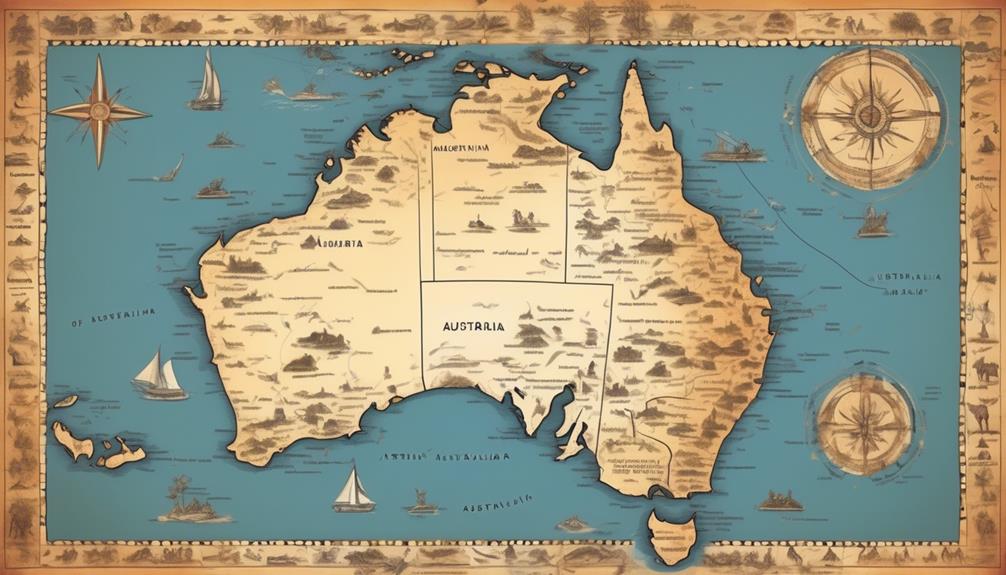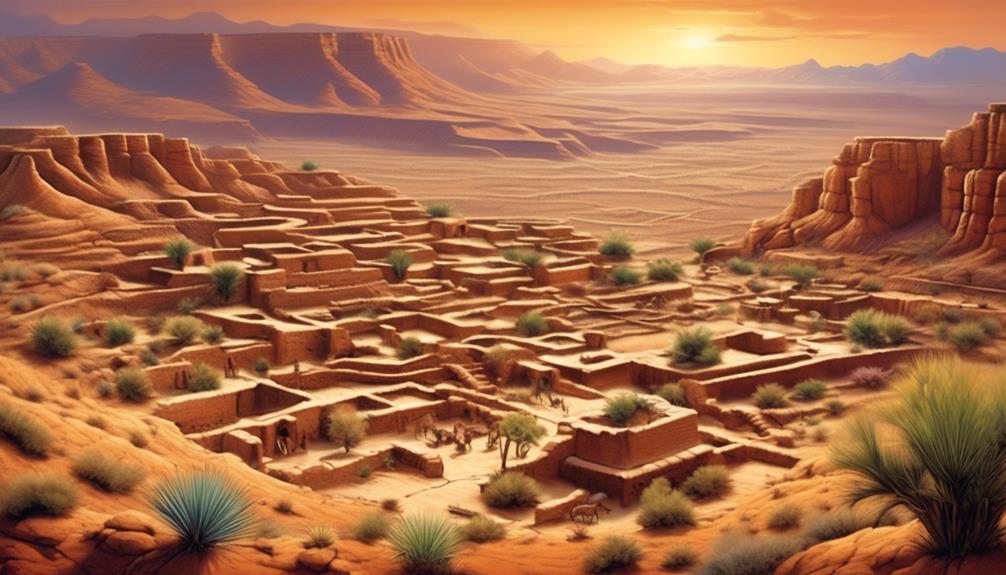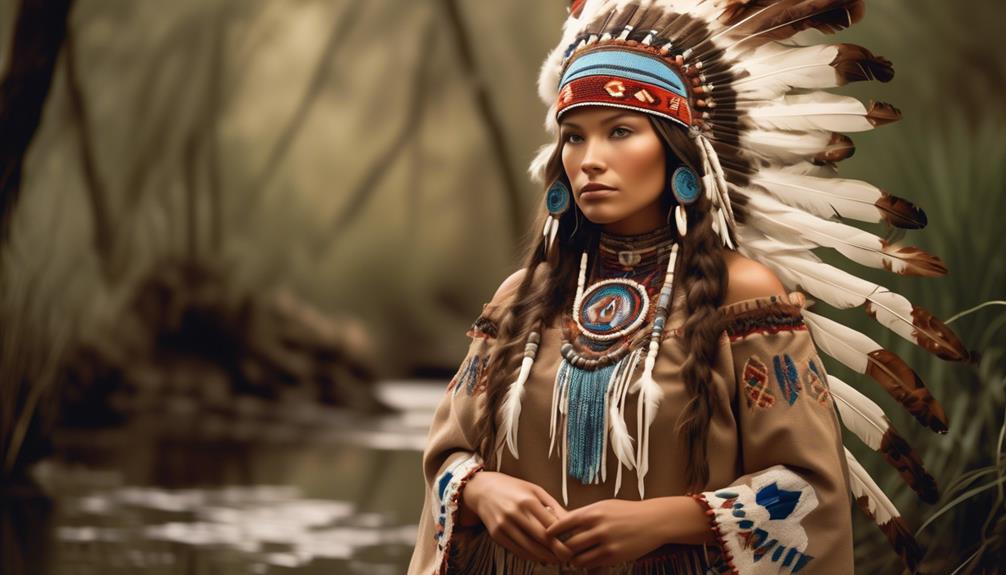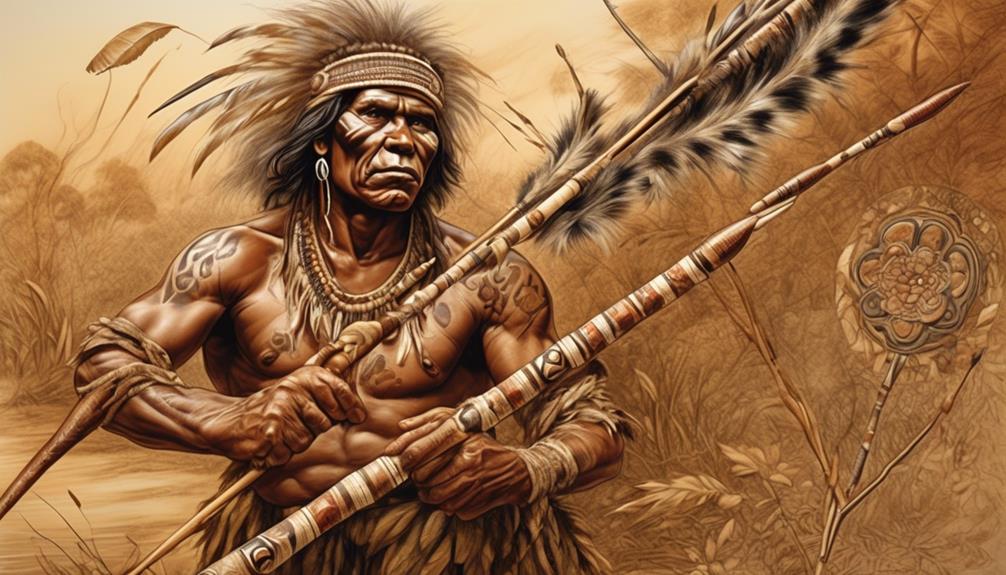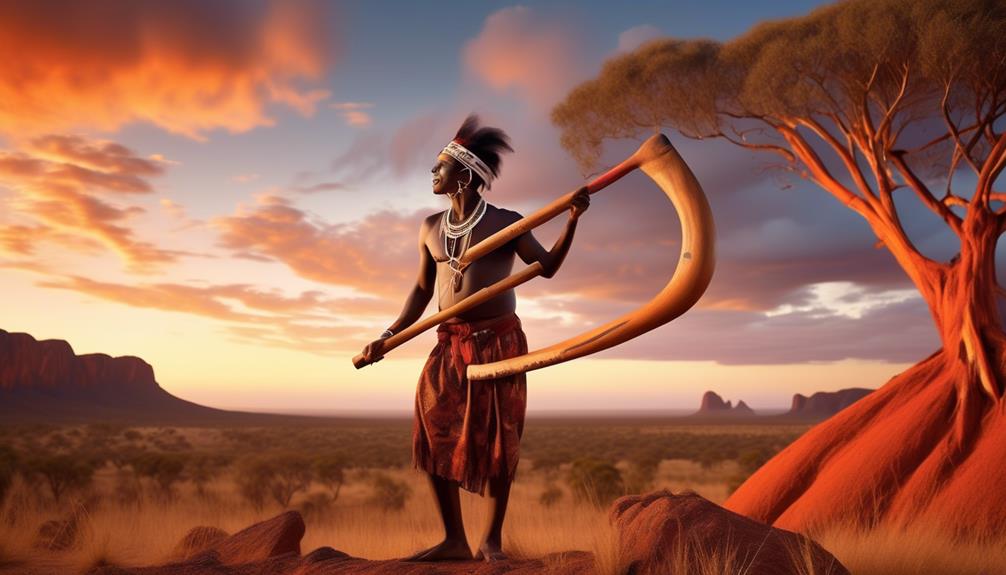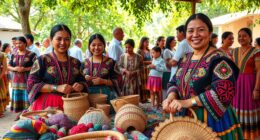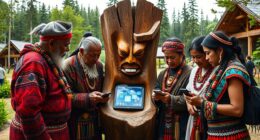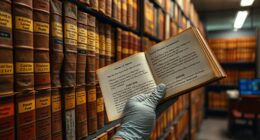The origins of Native Aboriginal Australians have long been a subject of interest and debate. The issue of their lineage is complex, with various theories and evidence contributing to our understanding.
From genetic studies to ancient oral traditions, the search for their origins has led to intriguing discoveries that shed light on the deep history of human migration and settlement. But how did these diverse strands of evidence come together to reveal the origins of Australia's first inhabitants?
The answer may surprise you.
Key Takeaways
- Aboriginal Australians arrived in Australia at least 65,000 years ago due to changes in climate and the search for new resources.
- Genetic studies reveal that Aboriginal Australians are descendants of one of the oldest known populations, showcasing their ancient origins and lineage.
- The Out-of-Africa Theory is supported by genetic studies, indicating that migration out of Africa occurred around 60,000 years ago and spread across Asia, Europe, and Oceania.
- Indigenous oral traditions and archaeological evidence both play important roles in preserving and understanding the cultural heritage, history, and lifestyle of Aboriginal Australians.
Early Arrival in Australia
Contrary to previous assumptions, recent archaeological evidence suggests that the early arrival of Aboriginal Australians on the continent occurred at least 65,000 years ago, making them one of the oldest continuous cultures in the world. The migration patterns of these early inhabitants remain a topic of fascination for researchers. It's believed that their journey to Australia was prompted by a variety of factors, including changes in climate and the search for new resources. This incredible feat of early human migration speaks to the resilience and adaptability of the Aboriginal Australians.
Upon their arrival, the early Aboriginal Australians faced the daunting task of environmental adaptation and settlement. Their ability to thrive in a range of diverse ecosystems, from arid deserts to lush rainforests, highlights their deep understanding of the land and its resources. Through their intricate knowledge of the environment, they were able to establish sustainable communities across the continent. This environmental adaptation and settlement were crucial in shaping the rich and diverse cultural tapestry that continues to endure to this day.
Understanding the early arrival and settlement of Aboriginal Australians provides valuable insights into the resilience and ingenuity of this ancient culture, offering a profound appreciation for their enduring legacy.
Genetic Studies and Ancestry

After establishing their resilience and adaptability in the face of environmental challenges, we now turn our attention to genetic studies and ancestry to gain a deeper understanding of the origins and lineage of the native Aboriginal Australians. Genetic diversity plays a significant role in unraveling the complex tapestry of Aboriginal ancestry.
Recent genetic studies have revealed that Aboriginal Australians are descendants of one of the oldest known populations in the world, with ancestors who undertook an incredible journey of ancestral migration. These studies not only shed light on the ancient origins of Aboriginal Australians but also emphasize the importance of recognizing and respecting the diversity within the Aboriginal communities.
Ancestral migration, as uncovered by genetic research, showcases the rich and intricate history of the Aboriginal people, highlighting the interconnectedness of diverse populations over thousands of years. These findings not only contribute to a more comprehensive understanding of human history but also honor the deep-rooted heritage of Aboriginal Australians.
Understanding the genetic ancestry of the native Aboriginal Australians is crucial in appreciating and preserving their cultural legacy.
The Out-of-Africa Theory
The Out-of-Africa Theory posits that anatomically modern humans originated in Africa before dispersing and populating other regions of the world. This theory is supported by genetic studies, which have revealed fascinating insights into migration patterns and genetic diversity.
- Genetic Studies: Through the analysis of mitochondrial DNA and Y-chromosome markers, scientists have traced the migration patterns of early humans out of Africa. These studies have provided evidence supporting the idea that all non-African populations are descended from a small group of individuals who migrated from Africa around 60,000 years ago.
- Migration Patterns: The genetic evidence suggests a single, rapid migration out of Africa, followed by the peopling of the rest of the world. This migration is believed to have followed a coastal route, with populations eventually spreading across Asia, Europe, and Oceania.
- Genetic Diversity: The genetic diversity found in non-African populations reflects the long and complex history of human migration and settlement across the globe, providing valuable insights into the rich tapestry of human evolutionary history.
Understanding the Out-of-Africa Theory and the genetic evidence supporting it allows us to appreciate the interconnectedness of all human populations and the remarkable journey our ancestors undertook to populate the world.
Indigenous Oral Traditions
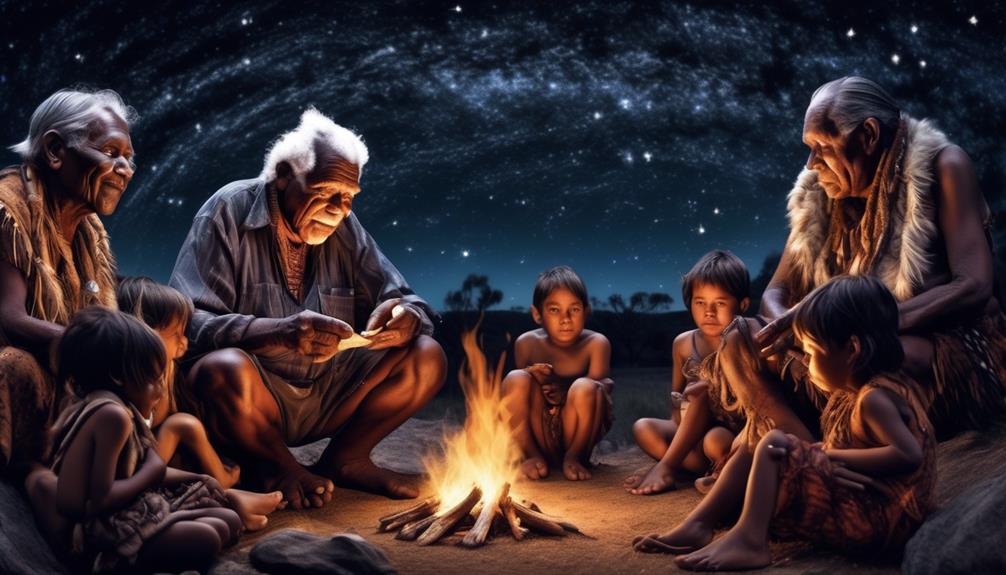
Drawing upon centuries of rich cultural heritage, Indigenous Oral Traditions serve as a vital repository of knowledge and history, transmitting valuable narratives across generations. Oral storytelling is deeply ingrained in the cultural fabric of Aboriginal Australians, playing a pivotal role in the preservation of their traditions. These stories, passed down through generations, encapsulate the spiritual beliefs, cultural practices, and historical accounts of Indigenous communities. They serve as a means of education, instilling values, ethics, and survival skills in the younger members of the community.
The oral tradition is a living, dynamic phenomenon, adapting to contemporary contexts while retaining its essence. It fosters a deep sense of connection to the land, ancestry, and spiritual realms. Through oral storytelling, Indigenous Australians uphold their cultural identity, fostering a strong sense of belonging and continuity within their communities.
Furthermore, the oral tradition acts as a mechanism for the transmission of historical events, ensuring that the collective memory of the community endures. It provides a unique perspective on the past, enriching our understanding of ancient times and serving as a testament to the resilience and wisdom of Indigenous peoples.
In essence, Indigenous Oral Traditions are a cornerstone of cultural preservation, embodying the essence of Aboriginal Australian heritage.
Archeological Evidence
Archeological evidence illuminates the intricate tapestry of Native Aboriginal Australians' historical journey and their deep-rooted connections to the land. Through the study of artifacts and ancient settlements, we gain insight into the migration patterns and environmental adaptations of the first Australians.
Here's how the archaeological evidence sheds light on the origins and lifestyles of the Aboriginal Australians:
- Migration Patterns: Excavations at sites such as Lake Mungo in New South Wales and Madjedbebe in the Northern Territory have revealed evidence of human occupation dating back over 65,000 years. These findings challenge previous theories about the timing and routes of human migration into Australia.
- Cultural Artifacts: The discovery of sophisticated tools, rock art, and ceremonial objects provides a glimpse into the rich cultural practices and spiritual beliefs of the early inhabitants. These artifacts not only showcase their artistic abilities but also offer clues about their social structures and daily life.
- Ancient Settlements: The remains of ancient settlements, including stone houses and fish traps, demonstrate the resourcefulness and environmental adaptations of the Aboriginal people. These structures reflect a deep understanding of the land and its resources, highlighting their sustainable and harmonious relationship with the environment.
Frequently Asked Questions
What Are the Traditional Ceremonies and Rituals Practiced by Native Aboriginal Australians?
We hold traditional rituals, including Dreamtime stories, sacred ceremonies, and ritualistic dances, close to our hearts. Our cultural practices are deeply intertwined with our indigenous spirituality, and each ritual carries profound significance.
These ceremonies often serve as a way to connect with our ancestors, honor the land, and maintain our cultural identity. Through these practices, we pass down our rich heritage and keep our traditions alive for generations to come.
How Has the Landscape of Australia Changed Since the Arrival of Native Aboriginal Australians?
The landscape of Australia has undergone significant changes since the arrival of native Aboriginal Australians. These changes have impacted the environment and culture in profound ways.
The impact of these changes can be seen in the rich traditions and deep connection to the land that Aboriginal Australians have maintained over thousands of years. The environment has shaped their culture, and in turn, their culture has shaped the environment, creating a unique and intertwined relationship.
What Role Did Women Play in Early Aboriginal Australian Societies?
In early Aboriginal Australian societies, women's roles were essential in leadership, spirituality, kinship, and preserving cultural heritage through art and storytelling.
They held significant influence and responsibility within their communities, contributing to the social, spiritual, and cultural fabric of their societies.
Women played a pivotal role in maintaining and passing down traditions, ensuring the continuity of their rich cultural heritage for future generations.
How Have Modern Australian Policies and Attitudes Impacted Native Aboriginal Australian Communities?
We've seen the impact of colonization on Native Aboriginal Australian communities. Modern Australian policies and attitudes have influenced cultural preservation and adaptation.
Unfortunately, these communities have faced significant challenges due to historical injustices and ongoing systemic issues. It's important to acknowledge and address these issues while also celebrating the resilience and strength of Aboriginal cultures.
What Are Some Common Misconceptions or Stereotypes About Native Aboriginal Australians?
Misconceptions and stereotypes about Native Aboriginal Australians are pervasive. Many are unaware of the rich cultural practices and diverse social roles within these communities.
Some believe outdated myths, perpetuating harmful biases. It's important to challenge these misconceptions and celebrate the true diversity and uniqueness of Aboriginal cultures.
Let's debunk these stereotypes and embrace the richness of Aboriginal heritage.
Conclusion
In conclusion, our understanding of the origins of native Aboriginal Australians is deepening through genetic studies, oral traditions, and archeological evidence.
We're learning more about their early arrival in Australia and their connection to the Out-of-Africa theory.
As we continue to uncover their rich ancestry, we honor and respect the enduring legacy of the indigenous peoples of Australia.
Mary is a passionate writer who brings creativity and a fresh perspective to our team. Her words have the power to captivate and inspire, making her an essential contributor to our content. Mary’s commitment to storytelling and dedication to promoting Indigenous culture ensures that her work touches the hearts of our readers. We’re fortunate to have her as part of our team.
